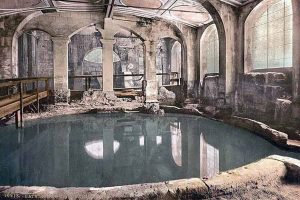Water is among the natural treasures highly valued from the deepest antiquity. It has been associated with religious and healing practices since time immemorial. As in the past, so today, people around the world rightly believe in its power. The oldest archaeological evidence of the special interest in water dates back to the distant Bronze Age /IV-II millennium BC/. In the culture of the Mediterranean, the first baths were found in the palace complex of Knossos on the island of Crete. The luxurious alabaster baths excavated in Akrotiri on the island of Santorini are also known from that time. The Hellenes considered natural springs to be blessed by the gods. It is no coincidence that the most famous divination site in Antiquity – the temple of Apollo in Delphi was located near a hot spring. “Serangeum” is the first known Greek term for a bath.

“Sanitas Per Aquam” – “HEALTH THROUGH WATER”
The Romans, taking advantage of the achievements of the Hellenes, developed the idea of baths to the highest degree, turning them into a sphere not just for bathing, but also for communication. Over 800 baths functioned in the capital city of Rome, which were free to visit by all social strata. The water in the thermal baths came thanks to the built aqueducts, and the heating was carried out with a special “hypocaust” system under the floor of the rooms. Notable as complexes and engineering facilities were the baths of the emperors Caracalla and Diocletian.
The Roman emperor Caracalla was distinguished by a cruel temper, not much intelligence, but combined with the endurance of an ordinary warrior. History does not speak favorably of him, but the spectacular baths he built in the center of Rome are his memorial. The Baths of Caracalla were built in 212-216. among lush green gardens. The building, lined with marble and mosaic floors, impressed with its dimensions, visible to this day: 225 by 185m. and a height of 38.5 m. The baths were extremely popular until the invasion of the barbarian Goths, who destroyed the aqueduct that supplied them with the precious water. Today, the impressive ruins are the largest concert stage in the world with a length of 22 meters and a circumference of 8,000 people.
The Baths of Diocletian surpass in size and splendor those of Caracalla. They were built between 298 and 306. on an area of 13,000 sq.m. The spacious complex included fountains, pavilions, libraries, gymnasiums and meeting rooms. The baths themselves were centrally located, consisting of rooms with different temperatures and functions, giving the ideas of modern day spas. Their capacity was remarkable: 3,000 visitors at the same time.
The first step to spa pleasures was the tepidarium, characterized by a pleasant air temperature, where the body was rubbed well, after which the Romans plunged into a small warm pool for relaxation. Next came the caldarium – the hottest room in the complex, characterized by high air humidity. It often consisted of several connected areas, including a hot pool and an ice fountain in succession. The modern steam bath approaches the idea of the tepidarium. The other rooms were: laconium /sauna/ and frigidaruim /cool water pool/. After all this, refreshed and rested, the Romans went to activities in the libraries and in the halls of fellowship. During the Renaissance, basilicas were built on the territory of the thermal baths, and in the 20th century, the Roman City Museum. The popular Termi railway station also rests on its foundations.
With the expansion of the Roman Empire, the concept of Roman baths spread over three continents: Europe, Asia and North Africa. This is how the foundations of the thermal centers popular to this day were laid: Aix and Vichy in France, Bath and Buxton in England, Aachen and Wiesbaden in Germany, Baden in Austria, Aquinicum – today’s Budapest in Hungary.
The Roman baths in Bulgaria
The lands of the Thracians became part of the vast Roman Empire in the first century. In Bulgaria, Ulpia Pautalia is the Roman name of Kyustendil, known as a place for the treatment and recovery of Roman generals. Diocletianopolis is today’s Hisaria, Medeka is today’s Varshets, Anchialo is Pomorie. Among the largest Roman cities with thermal baths on our territory are: Serdika /Sofia/, Raciaria /at 25 km. from Vidin/, Odessos /Varna/, Trimontsium /Plovdiv/ etc.
In the Middle Ages, Roman baths ceased to exist.
In 1326, Colin le Loup, an ironwork manufacturer from Liège, Belgium discovered water springs containing iron in the town of Spa, Belgium. Around these springs grew the famous health resort of Bath, as well as the term “spa”, which referred to any health resort located near natural springs. During this period, certain springs were associated with a certain disease that people could use for treatment.
In the 17th century, spa centers became popular: Carlsbad in Bohemia, Scarborough in England, and later Bath in England. Modern medicine became active on the question of the healing properties of mineral waters, which gave impetus to balneotourism and cleanliness of the urban environment in Europe. In the 19th century began the scientific study of various healing practices with mineral water and the creation of special regimes and schedules in the spa centers of the old continent.
The development of the spa business in the 20th century went hand in hand with the concept of healthy eating and diets, with gymnastics and various exercises. In a number of European countries, treatment in spa centers is becoming an important social policy.

During the last century, Bulgaria went in the modern direction.
The mineral composition and healing properties of the numerous mineral springs in the country have been studied. The long list includes 50 balneological resorts with over 225 mineral water deposits. Of these, 148 springs are located in Southern Bulgaria and 77 in Northern Bulgaria. Most mineral springs have warm water, but there are also hot and cold ones.
The most popular spa destinations in Bulgaria are the already mentioned heirs of the thermal baths from Roman times, whose sustainability over time is due to the connection of balneotourism with cultural tourism and the clean natural environment.

Today, interests in the spa industry are united by the Bulgarian Union of Balneology and Spa Tourism.











